One of the most iconic Taiwanese foods is the bah tsang (or zong zi, in Mandarin). These bamboo leaf wrapped glutinous rice dumplings are a traditional food for celebrating the Dragon Boat festival (Duan Wu Jie, which falls on...
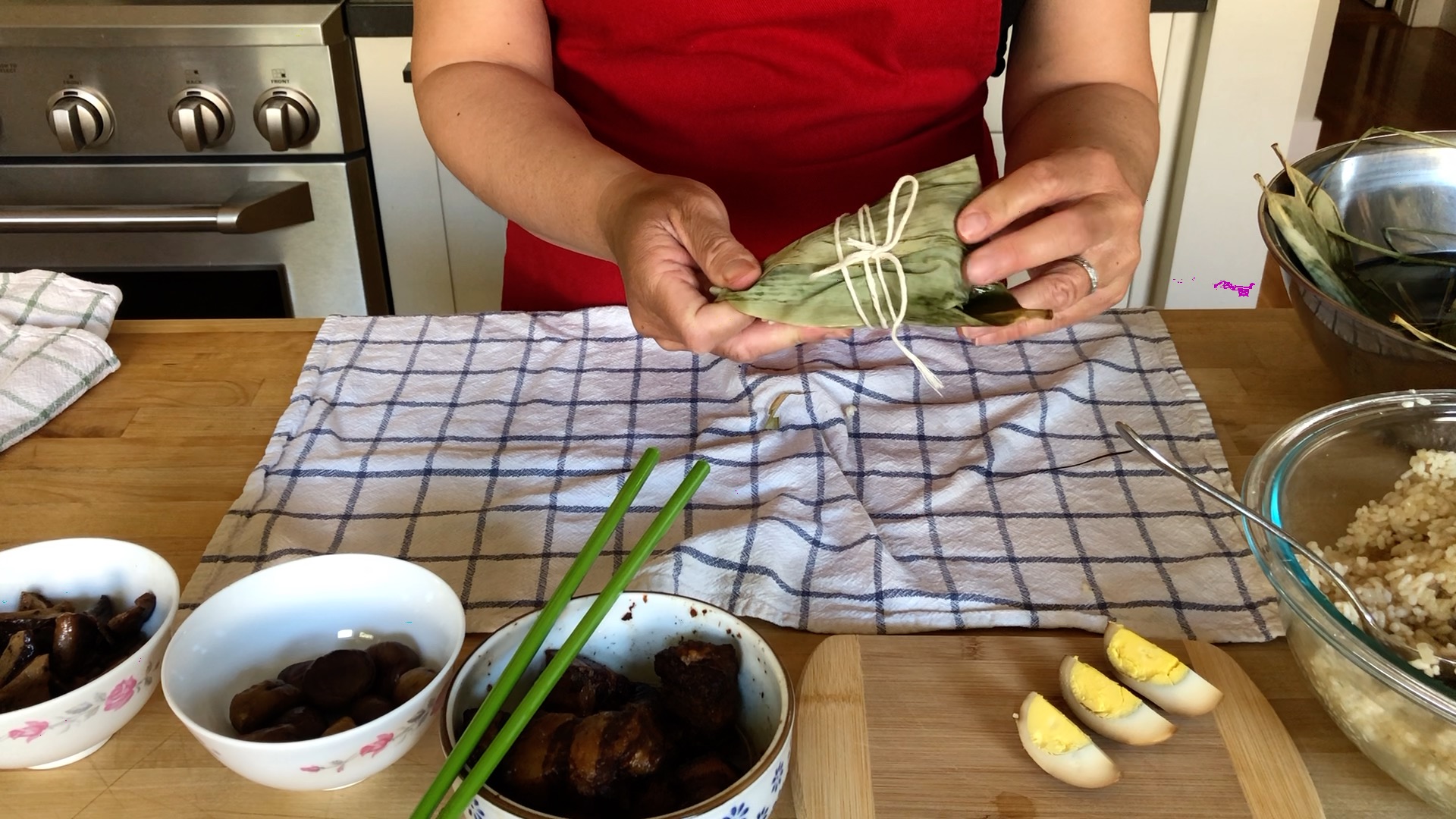
One of the most iconic Taiwanese foods is the bah tsang (or zong zi, in Mandarin). These bamboo leaf wrapped glutinous rice dumplings are a traditional food for celebrating the Dragon Boat festival (Duan Wu Jie, which falls on June 28 this year), as folklore has it that a Chinese poet drowned himself in a river over his unrequited love. Apparently, this river was home to some vicious flesh-eating fish. So the search party, desperate to keep the flesh-eating fish from devouring his body, threw bundles of rice wrapped in leaves, to stave them off.
But in Taiwan, bah tsang are not just a holiday dish. In the olden days, vendors walked through villages with bundles of these leaf-wrapped treats tied to a pole. Taxi drivers sometimes have little fabric replicas of these bah tsang bundles dangling whimsically from their rear-view mirrors.
A few years ago, I interviewed some older Taiwanese American women who are known in the community for their bah tsang folding skills. Here’s the story for Public Radio International. The ingredients are simple–rice, pork, egg, mushroom, and maybe nuts–but making them come together as more than the sum of its parts is not so easy. In my family, we usually bought some from an industrious auntie who ran an assembly line in her kitchen. Now, Asian markets like Ranch 99 have steam tables full of different styles of glutinous rice dumplings every June: sweet ones, with red beans or dates inside, as well as savory ones in Cantonese, Shanghai or Taiwanese style.
But even on the tiny island of Taiwan, there is disagreement about how bah tsang should be made. Is the rice raw or precooked? Is the pork simply marinated or braised? Salted duck egg yolks or a wedge of soy sauce egg? Some of this is a matter of personal taste, but there are two main types which generally fall along the lines of northern or southern styles. My relatives are from Taipei, so I’m making the northern style, with fillings that are already cooked. After all the insides are tied inside the leaves, the bah tsang are steamed. In the south, the fillings are prepped–but raw–and the finished bundles are submerged in water and boiled for a longer time to ensure they are thoroughly cooked.
Over the past few years, I’ve had a chance to make bah tsang with my mom and also with several other Taiwanese Americans, and I’ve picked up some tips to make this very daunting task seem less scary.
Maybe you’re a visual learner, and you’ll want to jump right into watching my video tutorial. If you want the recipe and step-by-step directions, keep scrolling…
Recipe: Northern Taiwanese Bah Tsang
Ingredients
48 dried bamboo leaves (sold in Asian markets, most often in May or June), soaked in water for at least 4 hours or overnight
6 c. glutinous rice, rinsed and soaked in water for 4 hours or overnight
1 very large shallot, peeled and minced (you may need multiple small shallots, to total 1/4 c.)
6 large shiitake mushrooms (soaked, if using dried and then stemmed and cut into quarters)
1 lb. pork belly, cut crosswise into 1/2? slices
24 dried chestnuts
6 hard-boiled eggs
Pork braising sauce:
2 T. soy sauce
1 T. dark soy sauce
1 T. Xiao shing jiu (Taiwanese rice wine)
1 T. sugar
3 garlic cloves, minced
1/2 t. Five spice powder
Rice seasonings:
3 T. soy sauce
1 T. sesame oil
2 t. white pepper
2 t. salt
1-2 c. water
Kitchen twine, cut into 24 15? segments, longer if you want to bundle all the tsang together
Directions – Prepping the fillings
Step 1: Pork and eggs
This can be done the day before, so that all the fillings are prepared and ready to go when it’s time for assembly. Combine all the ingredients for the pork braising sauce in a heavy bottomed pot or Dutch oven. Add two cups water and pork. Bring to a boil, skimming off any scum that rises to the top, then reduce heat. Add hard boiled eggs and simmer very low for 1-2 hours, spooning sauce over the pork and turning the eggs gently once in a while, until the pork is tender. It will cook further when the finished bah tsang is steamed. Be careful not to overheat the eggs or they will crack or become rubbery. Let cool and refrigerate, if preparing ahead of time.
Step 2: Soak all the dried things
Put the leaves in a sink full of water or a very large basin or bowl. If the container isn’t big enough for the leaves to lay flat, adjust them once in a while to ensure that all the parts get rehydrated. Pay extra attention to the stem ends, which tend to be tough. Rinse and soak the rice, straining before you move on to the next steps. If you are using dehydrated shiitakes, this is a good time to soak those, as well. These steps can also be done the night before.
Step 3: Par-cook the rice
Heat 3 T. of oil over high heat in a large wok or heavy frying pan. You may need to do this in batches if your wok isn’t big enough. Add the soaked and drained rice, along with seasonings. Keep turning the rice, and add a little extra oil if it sticks to the pan. After the rice starts to look shiny and golden, drizzle in the water, about 1/4 c. at a time, covering the wok, to keep the steam in. Keep adding the water a little at a time. The grains of rice will start to look more opaque and plump, but they will not be overly sticky. When all the water is absorbed, turn off the heat and cover the pan while you assemble the other fillings.
Step 4: Mise en place
Get all the fillings ready and arranged in small bowls near your workspace. Quarter the mushrooms, Cut the eggs into four wedges, remove the pork from the braising liquid, and take the chestnuts out of the packages, cutting them in half if they are too big.
Wrapping
Now, it’s showtime! Layout all your ingredients in the order your will be using them and give yourself a good amount of workspace. Keep a towel handy, because this can be wet and messy work!

Take two rehydrated bamboo leaves and lay them, stem end facing the center, in one horizontal line. The leaves should overlap by 5-6 inches in the center.
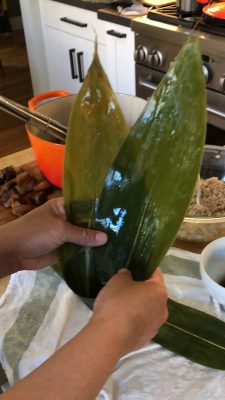
Bring the ends of the leaves toward the center, forming a cone in the middle. The part of the leaf away from you (on the other side of the vein that runs lengthwise down the center) should be folded over a little
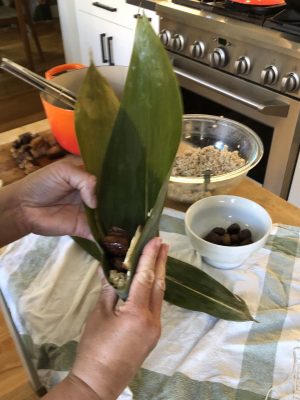
Place a spoonful of rice in the bottom of the cone, packing it down and towards the back of the cone. Set a piece of in the center, pressing it down into the rice. Place the rest of the ingredients in the center, firmer ones first and then ending with the egg.
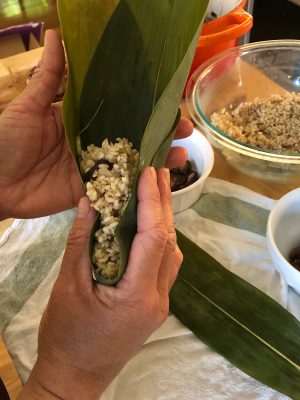
Spoon some more rice on top of the fillings, compacting it down.
Then, squeeze the open part into a “V” shape with hand and get ready to fold the top parts of the leaves with the other…
Then, squeeze the open part into a “V” shape with hand and get ready to fold the top parts of the leaves with the other…
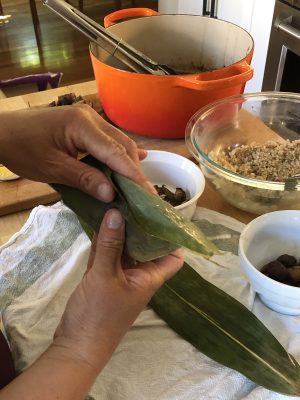
Fold one of the leaf ends over the opening, making sure to tuck the loose edges inward, so the rice doesn’t fall out.
Then do the same with the other leaf. If there were any gaps left from the first leaf, try to angle the second leaf to cover those spaces.
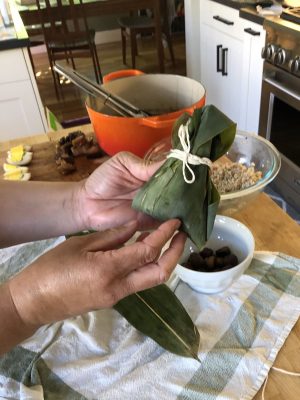
Carefully tie a string around the middle, binding any looser areas and tucking the tips of the leaves under the string, if possible.
Repeat 11 more times ;)
Steam for 20 minutes on low pressure in the Instant Pot, followed by natural release, or steam on the stove for 40 minutes. Feel proud of mastering homemade bah tsang. Enjoy!
The post How to Fold Bah Tsang, With a Video Tutorial appeared first on HapaMama.











